
scrounge: /skrounj/ informal verb: to actively seek [books] from any available source

Destination: Planet Earth is a very thorough, colorful journey over our home planet -- landforms, earth science, geography. Each double-page spread includes a large illustration and small text blocks around it that cover details about each place or topic, such as mountains, the coastline, plate tectonics, volcanoes, biomes, etc.
At the end there's a couple sections about pollution and some of the things we can do to help reduce waste. The book as a whole really makes you feel like an explorer!
(Thanks to NetGalley for the review copy.)
Scrounged From: NetGalley
Format: Kindle
Author: Jo Nelson
Illustrator: Tom Clohosy Cole
Pages: 40
Content Advisory: None
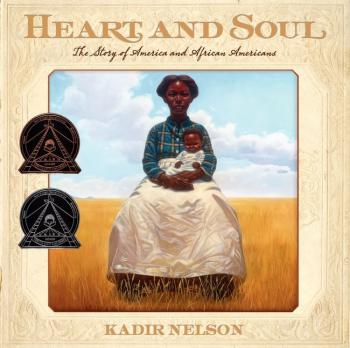
It's not that I'm going out of my way to select books illustrated by Kadir Nelson -- it's just that he seems to be the current master of illustrating the African American story, and so many of his books are highly acclaimed, and rightly so. His illustrations here evoke a strong sense of determination, identity, and community, among other things.
Heart and Soul: The Story of America and African Americans is the stunningly illustrated story of African Americans in America -- who have been here since long before the country became independent, and have contributed so much to America's success and sense of identity ever since.
Written in a voice that is both informative and informal, this story traces African Americans' history, from the first settlers through slavery, the Civil War, Reconstruction, Jim Crow, and the fight for Civil Rights. It also includes some lesser-known aspects of African American history, such as various inventors, and people who went west during westward expansion, including cowboys.
The narrative occasionally makes reference to grandparents and uncles, etc., but it wasn't clear to me until the end who the narrator was supposed to be. At first I thought it was simply meant to be a "collective" voice, but in the epilogue it becomes more clear that the narrator is someone who is very old, who culminates her story with a vote for Barack Obama, the first African American president of the United States.
Of course, trying to fit such a large amount of history into a book this size is a challenge, and can result in gaps and lack of nuance in the treatment of some topics. Still, this is a very valuable contribution to history written for children, and would make a great addition to any US history classroom or homeschool program.
Scrounged From: Our local library
Format: Hardcover
Author/illustrator: Kadir Nelson
Pages: 112
Content Advisory: References are made to violence in the context of slavery and war.
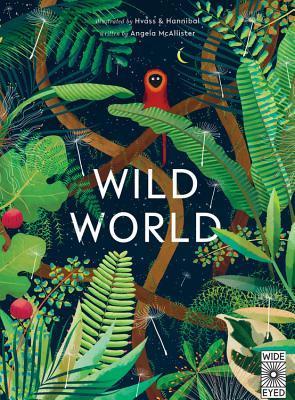
I really enjoyed Wild World, a collection of poetry about many of Earth's most recognizable wild places that contain animal habitats. The poetry is paired with lovely, colorful illustrations featuring many animals found in each type of place.
The poetry contains some wonderful imagery and metaphor, and as such is probably beyond preschoolers, but for older children and adults this is a lovely way to learn and be reminded about these animal habitats, and references to the food chain help prevent these vignettes from becoming romanticized. There are some general environments covered here such as jungles, deserts, mountains, etc., but also some more specific ones such as moorlands, mangroves, and the Australian Outback.
(Thanks to NetGalley for the review copy.)
Scrounged From: NetGalley
Format: Kindle
Author: Angela McAllister
Pages: 32
Content Advisory: None
Today's Christmas book post is actually four books (or more!). When I was growing up, I loved reading the American Girl book series produced by Pleasant Company. These fictional stories of girls from the past helped to highlight some of the differences and similarities between people from different time periods and circumstances.
Each of the original series contain six short chapter books, and book three is the Christmas story. In every book of the series, there is a "Looking Back" section at the end that gives more details about what life was like during the time period of each particular character.
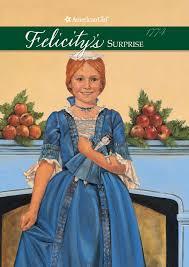
Felicity is growing up in Colonial Williamsburg around the time of the American Revolution. In Felicity's Surprise, she is invited to a dancing lesson at the governor's palace, but when her mother falls ill, she has to spend all her time caring for her, and accepts that she probably will not get to go. But, surprises can still happen!
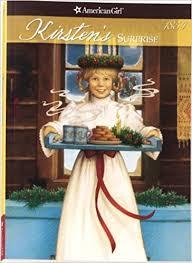
Kirsten is a member of a pioneer family that emigrates from Sweden in the first book in her series. In Kirsten's Surprise, Kirsten and her father are caught in a blizzard on their way home from retrieving the family's trunks from their journey. But in the end, we get a glimpse of some of the traditions involved in the Swedish celebration of Saint Lucia's Day.
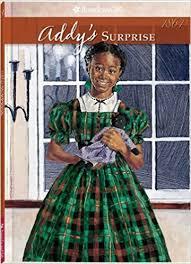
In the first book of her series, Addy and her mother escape from slavery after their family is split up by their master. In Addy's Surprise, Addy and her mother are making a life for themselves in Philadelphia, but money is tight, and they wonder if they will ever see the rest of their family again. But as they plan small surprises for each other, they are in for an even bigger surprise at the end (I have a summary of this whole series here).
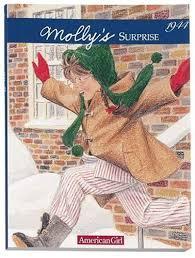
Molly lives in America during World War 2, and her father is away in England working as a doctor during the war. Even though Christmas is coming in Molly's Surprise, the family knows their father may not have time to send them anything because he is so busy. But when Molly and her sister find a package with instructions to keep it hidden, they decide they have been entrusted with keeping the surprise in Christmas.
Scrounged From: Presents from my childhood
During my later elementary years, I really enjoyed reading the historical book series of The American Girls Collection, produced by Pleasant Company. As an adult, there are some I like more than others now, but Addy, written by Connie Rose Porter, is still my favorite. These series give girls (and boys too!) the opportunity to learn about history through characters close to their own age. The original series all follow the same six-book formula, and though the main characters are all growing up in different time periods, they all display courage and hope in various ways.
Each book contains many realistic illustrations, and a "Looking Back" section after the story that includes photographs and drawings, to give some more historical context to the setting and events described.
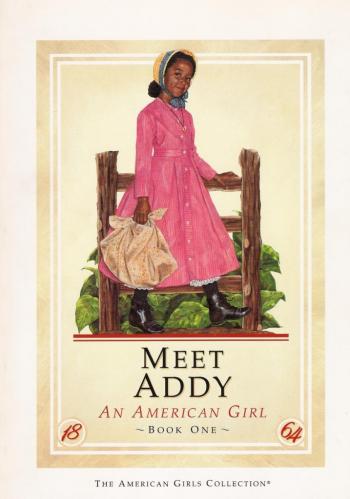
Meet Addy:
In the first Addy book, we are introduced to Addy, a nine-year-old girl who is a slave on a plantation near the end of the Civil War. But in the very first chapter, Addy lies awake at night and listens to her parents talk about freedom -- they plan to run away. But before they get the chance, Addy's father and brother are sold. Addy's mother makes the difficult decision to run away anyway, and leave her one-year-old baby behind with Addy's aunt and uncle, hoping that the family will all meet up again in Philadelphia someday.
Reading this as an adult/parent has a whole different dimension to it. While this series obviously does not even begin to touch on all the horrors of slavery, reading about the punishments and family separations still had an effect on me as a child, and this story made it seem much more real than a history textbook could have.
Looking Back: This section gives a brief history of slavery in the US, as well as the underground railroad and Harriet Tubman, and the beginnings of the Civil War.
Addy Learns a Lesson:
This story is about Addy's introduction to school, and we get to see her navigate the difficulties of getting an education, and of friendship. Addy and her mother arrive safely in Philadelphia, but have almost nothing. They find help and hospitality at a church, and are soon able to earn a living, though making ends meet is difficult. But Addy is determined to learn how to read, and her determination begins to pay off. In addition to learning to read, she learns about what is most important in her friendships.
Looking Back: This covers the difficulties that African-Americans had in obtaining an education during this time (and previously), and the formation of some of the earlier schools.
Addy's Surprise:
Addy and her mother are working very hard, but they are still having a hard time affording basic necessities. Still, as Christmas arrives, they both want to find ways to surprise each other. Even in the midst of their difficulties, Addy is faced with the realization that there are still so many others that are worse off than her and her mother, and both she and her mother do their best to help with what little they have. At the end, Addy recieves a wonderful Christmas surprise as one of her family members reunites with her and her mother again.
Looking Back: Holidays were much simpler in this era anyway, but during the Civil War, most families could not afford "extras." Still, many found ways to make their Christmas celebrations meaningful and festive. This section also touches on the celebration of Juneteenth, as well as the later introduction of Kwanzaa.
Happy Birthday, Addy!:
In this story, Addy meets an elderly woman named M'dear, who is blind. Despite the fact that she can't see, M'dear is able to perceive more than she appears to. Since Addy was born into slavery, she doesn't know what day she was born on -- only that she was born in the spring. M'dear encourages her to "claim" a birth date -- when she finds a day that feels right to her.
Addy continues to learn and hope and work at her education, but the streets of Philadelphia sometimes teach her some ugly things -- that she and others like her can be freely discriminated against just because of the color of their skin. Still, the story ends on a positive note, with hope that someday things will get better.
Looking Back: This section covers certain lifestyle issues of the time period: birth, children's games, education, jobs, and the way the Civil War affected families.
Addy Saves the Day:
Addy and her family are working hard to earn extra money, still holding out hope that their remaining family members will be found soon. Meanwhile, their church puts on a fair to raise money to help wounded soldiers, widows, and separated families. Addy and her friends choose to make spool puppets and put on a puppet show. But not all of her friends are easy to work with. The fair goes well, but when something goes wrong, Addy chooses to take action. At the end, she gets a wonderful surprise.
Looking Back: This section talks about city parks and other public recreation during this era, and about things families did during their leisure time.
Changes for Addy:
The Walker family has been steadfastly searching for the rest of their remaining family members. Addy has been writing letters and not hearing anything back, which is discouragaing, but she never gives up hope. Then one day, she receives an answer, and is sure that very soon, their family will be whole again. She is mostly right, but also has to suffer the pain of loss, as so many other families do.
Addy's experience is also contrasted with her friend Sarah's, which was unfortunately common. While Addy makes good progress with her education and hopes to be a teacher someday, she is saddened when her friend Sarah has to drop out of school in order to earn enough money for her family to pay their rent. In the midst of the hope and determination, it is important to see this side of things too, that some people, as Sarah's mother puts it, "got to eat today and pay for this here room tomorrow. We can't be dreaming about someday."
The story ends with Addy reading the Emancipation Proclamation at her church.
Looking Back: After the Civil War, Reconstruction brought many advancements for African-Americans, but not all of it lasted -- the South soon instituted "black codes," and made segregation worse. This section concludes with an overview of the Civil Rights movement, up through the life of Martin Luther King Jr.
As much as I like this series, it is still worth pointing out to children that Addy is fortunate in many ways: she is able to stay in school and obtain an education, and she is able to at least discover the fate of all of her missing family members, which was not the case for many children who were in a similar situation.
Scrounged From: A birthday present from my childhood


